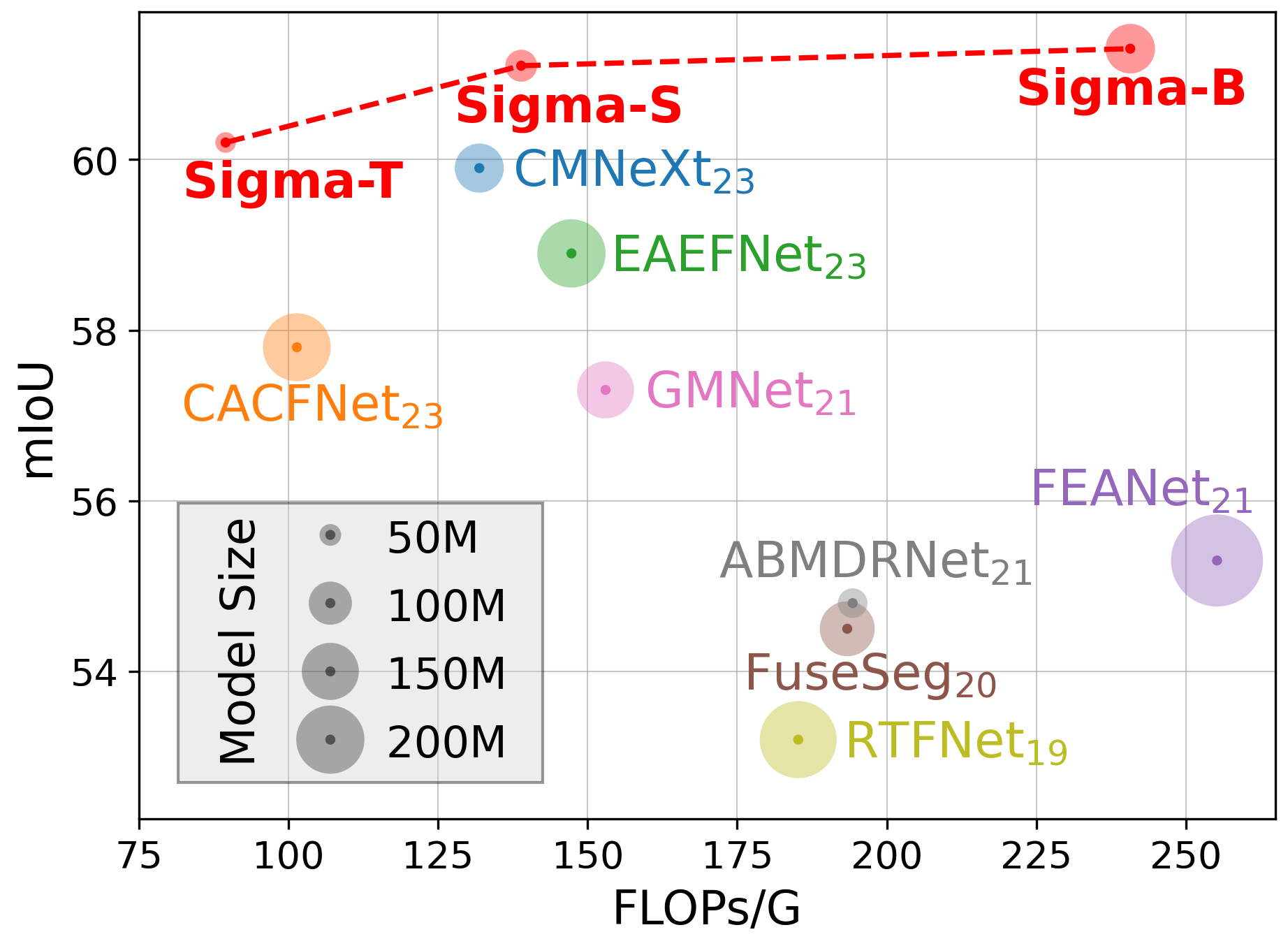Zifu Wan1, Yuhao Wang2, Silong Yong1, Pingping Zhang2, Simon Stepputtis1, Katia Sycara1, Yaqi Xie1
1 Robotics Institute, Carnegie Mellon University, USA
2 School of Future Technology, Dalian University of Technology, China
This repository contains the code for our paper Sigma: Siamese Mamba Network for Multi-Modal Semantic Segmentation. [Paper]
Sigma, as a lightweight and efficient method, reaches a balance between accuracy and speed. (Results below are calculated on MFNet dataset)
We test our codebase with PyTorch 1.13.1 + CUDA 11.7 as well as PyTorch 2.2.1 + CUDA 12.1. Please install corresponding PyTorch and CUDA versions according to your computational resources. We showcase the environment creating process with PyTorch 1.13.1 as follows.
-
Create environment.
conda create -n sigma python=3.9 conda activate sigma
-
Install all dependencies. Install pytorch, cuda and cudnn, then install other dependencies via:
pip install torch==1.13.1+cu117 torchvision==0.14.1+cu117 torchaudio==0.13.1 --extra-index-url https://download.pytorch.org/whl/cu117
pip install -r requirements.txt
-
Install Mamba
cd models/encoders/selective_scan && pip install . && cd ../../..
-
We use four datasets, including both RGB-Thermal and RGB-Depth datasets:
Please refer to the original dataset websites for more details. You can directly download the processed RGB-Depth datasets from DFormer, though you may need to make small modifications to the txt files.
-
We also provide the processed datasets (including RGB-Thermal and RGB-Depth) we use here: Google Drive Link.
-
If you are using your own datasets, please orgnize the dataset folder in the following structure:
<datasets> |-- <DatasetName1> |-- <RGBFolder> |-- <name1>.<ImageFormat> |-- <name2>.<ImageFormat> ... |-- <ModalXFolder> |-- <name1>.<ModalXFormat> |-- <name2>.<ModalXFormat> ... |-- <LabelFolder> |-- <name1>.<LabelFormat> |-- <name2>.<LabelFormat> ... |-- train.txt |-- test.txt |-- <DatasetName2> |-- ...
train.txt/test.txtcontains the names of items in training/testing set, e.g.:<name1> <name2> ...
-
Please download the pretrained VMamba weights:
Please put them under
pretrained/vmamba/. -
Config setting.
Edit config file in the
configsfolder.
Change C.backbone tosigma_tiny/sigma_small/sigma_baseto use the three versions of Sigma. -
Run multi-GPU distributed training:
NCCL_P2P_DISABLE=1 CUDA_VISIBLE_DEVICES="0,1,2,3" python -m torch.distributed.launch --nproc_per_node=4 --master_port 29502 train.py -p 29502 -d 0,1,2,3 -n "dataset_name"
Here,
dataset_name=mfnet/pst/nyu/sun, referring to the four datasets. -
You can also use single-GPU training:
CUDA_VISIBLE_DEVICES="0,1,2,3,4,5,6,7" torchrun -m --nproc_per_node=1 train.py -p 29501 -d 0 -n "dataset_name"
-
Results will be saved in
log_finalfolder.
-
Run the evaluation by:
CUDA_VISIBLE_DEVICES="0,1,2,3,4,5,6,7" python eval.py -d="0" -n "dataset_name" -e="epoch_number" -p="visualize_savedir"
Here,
dataset_name=mfnet/pst/nyu/sun, referring to the four datasets.
epoch_numberrefers to a number standing for the epoch number you want to evaluate with. You can also use a.pthcheckpoint path directly forepoch_numberto test for a specific weight. -
If you want to use multi GPUs please specify multiple Device IDs:
CUDA_VISIBLE_DEVICES="0,1,2,3,4,5,6,7" python eval.py -d="0,1,2,3,4,5,6,7" -n "dataset_name" -e="epoch_number" -p="visualize_savedir"
-
Results will be saved in
log_finalfolder.
We provide our trained weights on the four datasets:
| Architecture | Backbone | mIOU | Weight |
|---|---|---|---|
| Sigma | VMamba-T | 60.2% | Sigma-T-MFNet |
| Sigma | VMamba-S | 61.1% | Sigma-S-MFNet |
| Sigma | VMamba-B | 61.3% | Sigma-B-MFNet |
| Architecture | Backbone | mIOU | Weight |
|---|---|---|---|
| Sigma | VMamba-T | 88.6% | Sigma-T-PST |
| Sigma | VMamba-S | 87.8% | Sigma-S-PST |
| Architecture | Backbone | mIOU | Weight |
|---|---|---|---|
| Sigma | VMamba-T | 53.9% | Sigma-T-NYU |
| Sigma | VMamba-S | 57.0% | Sigma-S-NYU |
| Architecture | Backbone | mIOU | Weight |
|---|---|---|---|
| Sigma | VMamba-T | 50.0% | Sigma-T-SUN |
| Sigma | VMamba-S | 52.4% | Sigma-S-SUN |
Our dataloader codes are based on CMX. Our Mamba codes are adapted from Mamba and VMamba. We thank the authors for releasing their code! We also appreciate DFormer for providing their processed RGB-Depth datasets.
If you have any questions, please contact at zifuw@andrew.cmu.edu.
If you find this code useful, please consider citing our work:
@article{wan2024sigma,
title={Sigma: Siamese Mamba Network for Multi-Modal Semantic Segmentation},
author={Wan, Zifu and Wang, Yuhao and Yong, Silong and Zhang, Pingping and Stepputtis, Simon and Sycara, Katia and Xie, Yaqi},
journal={arXiv preprint arXiv:2404.04256},
year={2024}
}



